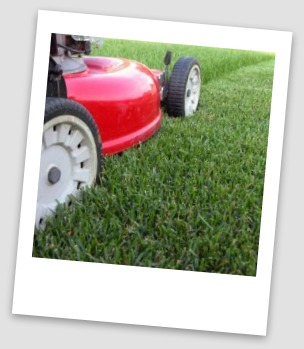B. Mowing Lawn
This short module on mowing lawns, will show do-it-yourselfers the right techniques, and the value of doing it right. Cutting grass may seem like a pretty simple task, but are you doing it right?
There are some basics on how to mow a lawn the right way, and some helpful lawn mowing tips starting with your lawn mower. We want to give you the basics on how to cut grass properly so you don't end up with lawn problems.
Before you begin with mowing lawn, you should head into the garage or shed and turn over your mower.
Are the blades sharp? Grass is a living organism, and mowing is similar to pruning. When pruning, you always use sharp pruning shears for nice clean cuts. You should be doing the same thing with your grass. Tearing the grass can actually damage the grass blade.
If your blade is not sharp you will notice the tips of the grass will turn brown shortly after mowing. This means it's time to take the blade off and have it sharpened either with a file, or by bringing it in to a tool sharpener. It is recommended to do this a few times a year.

Try not to remove more than the top 1/3 of the grass blade when mowing lawn. By leaving your lawn taller, you can cut down on the chances of weeds getting a foothold. It will also help shade the soil and roots from drying out faster.
If you are on water restrictions, let your grass grow as tall as your mower will allow.
Never scalp your lawn by mowing it too short. This will also damage the root system. Studies have shown that grass mowed at higher heights will develop deeper root systems.
Leave the clippings to decompose into the soil, providing natural fertilization of nitrogen, phosphorus and potassium. This is just one more way to cut down on fertilizer use. They do not add to the build-up of thatch if you are following proper overall lawn care procedures.
They will break down quickly if you use a sharp blade and a mulching mower. This is like a mini composting system in your lawn. Studies have shown this can cut down on fertilizer use by as much as 30%.
Mulching mowers are designed to cut and re-cut the grass into very small pieces that will break down faster. Heavy users of quick release fertilizers have to mow more frequently. You may have to bag every other mowing. If you bag mowings and use them for compost, make sure you don't put grass that has recently been fertilized in the compost pile. Try to wait three or four mowings first.
If your grass has grown taller than normal due to heavy rains or being away from your home, “double cut” your lawn.
Cut at a higher setting first, then cut it again a couple of days later to bring it to the appropriate 1/3 level. Don't cut it all off in one shot.
Always try to mow when the grass is dry. Wet grass clogs the mower and forms clumps that don't mulch very well.
You can also mow in different directions each time when mowing higher to prevent the grass from being pushed down to the ground by the wheels in the same direction each time.
It's true. All these little things have been researched, and all contribute to a healthy lawn. A lush, thick, deep rooting lawn will combat weeds, disease, drought and winter kill. Mowing is an important part of a well rounded lawn care maintenance program.
Now let's talk about the importance of...fertilizing.
_____________________________________
Table of Contents: Lawn Care and Maintenance
Introduction: Lawn Care and Maintenance
A. Watering
B. Mowing
C. Fertilizing
D. Aerating
E. Dethatching
F. Topdressing
______________________________________
Go to The Yard: Landscaping How-to Modules
Check out our time and money saving e-book
How to avoid the biggest mistakes made by DIYers, designers, and landscaping companies.
Visitor
Favorites
Giggles 'n' Thoughts





